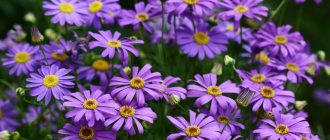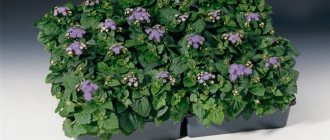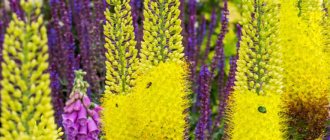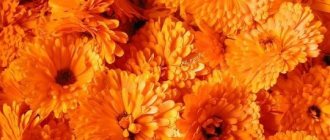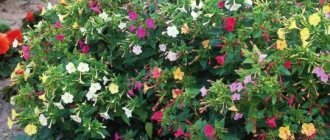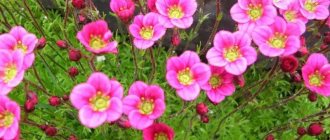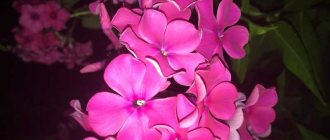The beautiful name Ageratum has Greek roots and is translated as “ageless,” which is associated with the possibility of long flowering without fading. The plant is also called Longflower. There are more than sixty plant species, but our most popular is Ageratum Mexicana. In Russia it is most often grown as an annual. Flowering - from June to October. Popular varieties: Blue Mink, Northern Lights, Blue Ball, White Ball, Pink Ball, Bonjour, Blue Fairy Tale, Snow Ball, Pink Ball, Ocean, Red Sea. The agricultural technique of growing ageratum from seeds at home is not complicated, but you need to know how to plant the crop correctly and care for the seedlings.
Characteristic
Ageratum (planting and care, photos provide a complete description of a flower plant that can be planted in an open area to create a landscape interior) is mainly cultivated in tropical countries, namely in South America and Mexico.
The plant is found in eastern India. Since the crop does not tolerate severe frosts, in Russia the flower is cultivated as an annual plant. The flower is considered heat-loving; it can be grown for several years at home or in greenhouse conditions.
The plant has a strong root system, so Ageratum quickly adapts to a new area. The culture is a small shrub with shoots, the height of which does not exceed 60 cm. The plant is covered with small green foliage.
Flowers with shoots and foliage are covered with soft fibers, giving Ageratum a decorative appearance. Lilac and blue inflorescences have a tubular shape and are located in the bushy part. The petals resemble soft and long needles. Ageratum is characterized by long flowering, which lasts for 5 months. The process begins in May and ends in October.
During the flowering period, the bush is covered with lilac, white or pink flowers.
The plant is often used to create a landscape interior, since the flower harmoniously combines with other garden crops. It can be used to decorate carpet paths.
The photo shows different varieties of ageratum.
The flower has a huge number of varieties that have their own characteristics:
- "Blue Mink" It is considered the most popular variety. It has large flowers that are colored in a rich purple hue. Based on this variety, a huge number of hybrids have been created, which are characterized by small sizes.
- "Mexican". The height of the plant is approximately 50 cm. It is divided into herbaceous and shrubby species. In corymbose-shaped inflorescences there are flowers of a bluish tint with a purple tint. The variety is light-loving, adapts normally to sunlight and is not afraid of elevated temperatures.
- "Summer Snow" The shrub is miniature and not very branched. The plant is covered with small, light green leaves. Light flowers are collected in umbrella-shaped shields. The foliage is densely distributed over the entire surface of the bush. The flowering stage begins in June and lasts until the end of the autumn season. The variety is resistant to sultry heat. The plant is mainly planted in flowerpots or flower beds.
- "Pink Ball". It is considered an annual species of shrub with low branching. At the flowering stage, the plant is covered with fluffy pinkish flowers that have a fragrant aroma. The crop blooms from June to October. The leaf blade is pubescent and quite large. The variety prefers to be cultivated in nutritious soil. The Ageratum variety is used to decorate flower beds.
- "Bonjour". It is an annual low shrub, the height of which reaches approximately 25 cm. The flowering period begins in June and continues until the first cold weather. The inflorescences are characterized by their large size and corymbose shape. They contain flowers of various colors with a fragrant scent. Despite the fact that the culture is light-loving, it can be planted in a shady place. The variety is drought-resistant, suitable for mixed borders, ridges, flower beds and balconies.
- "Blanket of Snow" During the flowering period, the shrub is covered with snow-white flowers. They gather in paniculate and fluffy inflorescences. The plant is low-growing and spreading, reaching a length of approximately 25 cm. Suitable for creating flower beds.
- "White Ball". A low-growing, spherical bush covered with small light flowers. The variety can be cultivated on any soil and can withstand drought and semi-shaded areas. The flowering period lasts until frost. The shrub often decorates rocky hills, borders, balconies and flower beds.
- "Treasures of the Aztecs." The variety is propagated using seedlings. The flowering stage begins in summer and ends with the arrival of frost. The variety is suitable for growing in flowerpots, flower beds and borders.
Varietal assortment
The genus Ageratum includes about 60 species. Before buying seeds, you need to decide on the future planting location. If you plan to decorate a balcony, veranda, terrace or make a border, the first plan of a flower bed, you should choose dwarf and low-growing varieties , up to 25 cm high .
To create spots of color and place them closer to the center of the flower bed, taller ones are suitable - up to 60 cm .
The classification of varieties by height is presented in the table:
| Group | Height, cm | Variety names |
| Dwarf | 15-20 | Blue muff, Kalinka, Malinka, Pink shawl, A. Houston F1 Aloha white |
| short | 20-30 | Snow Blanket, Storm Cloud, Pink Cloud, Cardinal Bordeaux, Blue Mink, Blue Ball, White Ball, Pink Ball; mixtures – Bonjour, Aztec Treasures, Tricolor undersized, Colored carpet |
| Medium height | up to 60 | White bouquet, Purple bouquet, Blue bouquet, Red bouquet, Tricolor tall |
The plant looks beautiful in solo plantings, as well as in joint plantings with marigolds, zinnias, heleniums, rudbeckia, verbena, ever-flowering begonia, cineraria
I will share my observations. I planted Ageratum twice, choosing low-growing varieties. First I bought Blue Mink seeds. I grew seedlings on a south-eastern windowsill (sun until lunchtime), and planted them along the path along the path along with marigolds and zinnias (in the background). The plants were illuminated by the bright sun from approximately 11 a.m. to 4 p.m. The bushes grew strong, strong, and bloomed profusely. But they were tall enough, which made it possible to cut the flowers along with red zinnias for a school bouquet by September 1st. The bouquet turned out beautiful and unusual thanks to the contrast of shape and color.
“Cardinal Bordeaux” in an open balcony (north side) – photo by the author
Last spring I planted the variety “Cardinal Bordeaux” for balcony boxes. The seedlings grew on the southern windowsill and then moved to the northern open balcony. Result: the plants stretched up to half a meter, the leaves and inflorescences were small, and not as intensely colored as on a bag of seeds. The conclusion suggests itself: for cultivation it is preferable to allocate open sunny or slightly shaded places. Although I admit that bold pruning to half would have resulted in more compact plantings.
Preparation of planting material and propagation
Ageratum (planting and care, photos will help gardeners prepare planting material for propagation and planting in open ground) is grown by seedlings and seeds. The first method is considered faster compared to the second.
To plant seedlings, use soil from special stores intended for terrace or hanging plants. To prepare the substrate yourself, you need to mix the humus with soil.
When planting seedlings in spring, you should adhere to the following points:
- Seeds must be sown from February to April. You will need to pour the soil into a box, make grooves 1 cm deep in it and distribute the planting material evenly.
- After filling the seeds with soil, the boxes need to be covered with glass or film to create a greenhouse effect, retain moisture and increase the temperature inside the container. For full plant growth, it is necessary to keep the temperature at least 20 ℃. Shoots will appear after 2 weeks.
- Picking of seedlings must be done after 4 full-fledged leaves appear on the plant. Then the seedlings should be planted in separate containers and watered abundantly.
- Young flowers should be planted during the warm period at an air temperature of at least 20 ℃ at a distance of 20 cm from each other.
Cultivating a flower by cuttings has its own characteristics. During the first frost, the flowers are transplanted into household containers and brought into the house.
Flower propagation by cuttings is described in the following paragraphs:
- Cuttings should be cut in March. For good moisture absorption, the cut must be made oblique.
- Afterwards, the cuttings need to be placed for a short period of time in a solution that stimulates growth (for example, “Kornevin”).
- Next, the cuttings should be sent to separate containers and greenhouse conditions should be created for them by covering the containers with film or glass. The soil must be kept moist and the temperature within 22 ℃.
- After 2 weeks, the cuttings will root.
The young plant will need to be moved into the ground to a sunny area after the arrival of consistently warm weather.
Preparing the soil and planting site
When planning to cultivate a flower in the garden, you must take a responsible approach to choosing a place to plant the plant. Since the garden crop is heat-loving, the site should have a light and non-acidic soil layer. The open area should be well lit and protected from drafts.
Garden crops cannot withstand slight darkening. If you plant the plant in a semi-shaded area, the foliage will begin to thin out, the stems will grow upward, and flowering will be insignificant. Therefore, when cultivating a flower outdoors or at home in a pot, you must choose a place that receives a large amount of sunlight.
The soil should be light, loose and have good drainage. Therefore, before planting the plant, you need to carefully dig up the beds. The soil layer must be fertile. If necessary, you will need to add fertilizer to the soil.
The acidity of the soil should be low, since the flower prefers to grow in soil with a neutral or slightly acidic reaction. If the soil on the site is characterized by an acidic reaction, the soil will need to be fed with dolomite flour or lime. It is not recommended to use humus or organic matter, as they have a bad effect on the flowering of the plant.
The soil layer for seedlings must be prepared in advance, approximately 14 days before sowing.
To do this you will need to do the following:
- First you need to make a substrate. To do this, you need to mix humus with peat and sand. All components should be taken in the same volume.
- The resulting composition must be disinfected. To do this, you need to pour it with a manganese solution.
- The prepared soil must be transferred to a warm place and left there until sowing.
- During this time, the necessary microflora will be restored in the soil.
Instead of an afterword
Plant ageratum in sunny, wind-protected beds with nutritious, loose soil. It often happens that your site is located in an area with poor soils with a low humus content; do not be too lazy to feed the seedlings with complex fertilizers 2 times a season.
If you are an ardent opponent of chemical fertilizers and prefer to use only organic additives, remember that infusions of bird droppings and mullein provoke the growth of green mass to the detriment of flowering. If you want to achieve high decorativeness and lush inflorescences, do not overuse nitrogen. Alternate the infusion of bird droppings with an ash solution. It is the ash that contains ash and phosphorus, which are responsible for flowering.
Landing algorithm
Ageratum (planting and care, photos will help novice gardeners to properly plant the plant in open ground, taking into account the sowing time and agricultural conditions) is best planted outside in late May or early June. At this time, in many regions the night frosts ended and warm weather finally settled in.
Approximately 14 days before planting the plant in open ground, the prepared seedlings need to be hardened off. Otherwise, the planting material will take too long to take and often get sick, since it will have a weakened immune system. As a result, the plant will be more often exposed to various diseases.
To harden the container with pickled seedlings, you need to immerse it in warm water and take it out into the fresh air. The procedure should last no more than 40 minutes. Every day, the hardening time must be increased by approximately 20 minutes.
The procedure is carried out only in the absence of possible frost. Once hardening is complete, the seedlings can be transplanted outside. When the soil layer is prepared, the seedlings are stronger and the weather is warm all the time, the young seedlings can be transplanted into open ground.
The algorithm for planting garden crop seedlings consists of the following steps:
- Initially, you need to prepare the seat. When digging holes, it is imperative to maintain distance. The distance between planting holes will depend on what type of plant is grown in the garden: tall, medium-sized or low-growing. If an adult flower is large in size, the distance between the holes should be approximately 25 cm. For low-growing seedlings, the distance between the holes should be within 15 cm.
- Planting holes should not be very deep. The seedlings need to be dug into the bed to the level at which it grew previously.
- It is not recommended to compact the soil layer near the bush too much. The soil needs to be tapped a little.
- When the planting material is in the garden bed, the seedlings need to be irrigated with water. Thanks to this, the roots quickly adapt to the new location.
- It is not recommended to add humus or manure to the soil, as they negatively affect the flowering and growth of the crop. As a result, the plant may die.
- Upon completion of planting, the soil layer in the garden bed will need to be mulched. Thanks to this, the seedlings will be protected from possible night frosts and will be provided with a good drainage layer. It is advisable to use peat or sawdust as a mulching layer.
If Ageratum is cultivated as a houseplant, the containers should be spacious enough and have a good drainage layer. In the summer season, containers can be sent to the veranda, balcony, or hung under the windows.
At home, the plant will bloom even in cold weather.
To maintain a decorative appearance over a long period of time, you need to remember a few simple rules:
- Flower pots must be placed on a windowsill that faces south, as more heat and light get there.
- Watering must be carried out strictly at the root, without waterlogging the soil. The procedure is recommended to be carried out daily in the morning.
- It is advisable to take ready-made soil, since it will contain the required amount of organic matter and minerals. In this case, the substrate will have a loose structure, which will provide free access of air to the root system.
- It is best to use complex compounds as fertilizers. Fertilizing is required once every 6 months.
- As the flower grows, it needs to be divided and planted in wider containers.
When to plant seeds for seedlings
The timing of sowing ageratum is determined by the weather conditions of the area where it is cultivated.
Average sowing time in different regions:
- Central region – mid-March – early April;
- Northwestern region - mid-April;
- Ural – mid – end of April;
- Siberia - mid-April - early May;
- Central Black Earth and North Caucasus regions - mid-end of March.
Outdoor care
Planting and care with photos will tell you how to properly grow Ageratum in the country in compliance with basic agrotechnical rules.
Spraying, watering
Watering the flower must be done depending on the weather. During drought, the plant should be irrigated more often; during rainfall, there is no need to water. The flower does not tolerate high humidity, so when watering you should take into account the required amount of water so that you can only moisten the top layer of soil.
Water for irrigation must be fresh and prepared in advance. You need to prepare it in the morning before watering or in the evening so that it warms up in the sun and settles. Watering should be done in the evening before sunset.
Weeding of the soil must be done immediately after watering. The procedure is necessary to ensure that oxygen reaches the roots and to remove weeds that can choke the growth of flowers.
Top dressing
Throughout the life of the flower, the soil should remain loose and nutritious. The soil must be fertilized several times during the season, cleared of weeds and loosened. The first fertilizing should be done 2 weeks after planting the plant in the ground.
During the budding period, it is necessary to carry out a second feeding. To achieve maximum flowering and longevity of the plant, you can feed it a third time, but the procedure is not mandatory.
Organic-based fertilizers should be alternated with mineral ones. Compositions based on potassium and phosphorus are very beneficial for the plant. Fertilizing with a large amount of nitrogen is not recommended, because it accelerates the growth of shoots and delays the start of flowering of the plant.
Transfer
Before the first frosts appear, it is recommended to dig up the most lush bushes and place them in separate pots. The plant can be placed in the house, on the veranda or balcony. In the spring, you can take cuttings from the bushes, root them and plant them in open ground after the onset of warm weather.
When transplanting Ageratum, you can use the following recommendations:
- to reduce stress in the plant, in the autumn it can be transplanted into a pot and kept for some time in a cool room;
- after moving the plant into the house closer to winter, it will go into a dormant period;
- in the spring, after Ageratum is transplanted into open ground, it will continue to bloom.
Trimming, tying, pinching
In order for the flower to bloom profusely, it is important to remove faded inflorescences in time. It is worth cutting off the upper parts of the shoots that stretch upward. This is necessary to ensure dense growth of the bush. To give the bush a different shape, you can do anti-aging pruning once a month.
Pinching should be done for thicker tillering. When the shoots begin to stretch upward, it is necessary to cut off the upper parts of the shoots. For good growth, at least 6 leaves must remain on the shoot. The procedure should be performed to ensure abundant growth of young bushes and prolong the flowering period.
Temperature and humidity
Ageratum loves open areas and warm climates. The temperature required for comfortable flower growth ranges from +22 to +26 ℃. The flower does not tolerate frost, so it overwinters at home at temperatures from +10 to +15 ℃. The plant loves moisture very much, but it is not recommended to over-moisten the soil, because if the water stagnates, the process of rotting of the roots may begin.
Recommendations for growing seedlings
Some care tricks will help you grow beautiful flowers that are pleasing to the eye.
- Light is necessary for seed germination, so you should not bury the seeds when sowing.
- Periodic unfolding of the planting container allows you to prevent the seedlings from stretching and tilting to one side.
- The requirements for soil and air moisture are different. The soil should always be slightly moist, while the air should always be dry. It is not recommended to place seedlings in close proximity to a humidifier.
- Lack of sunlight and lack of ventilation lead to the development of fungal diseases.
- Pinching the tops of seedlings no higher than 3-4 internodes allows you to stimulate the growth of side shoots and form a strong, voluminous bush.
- Removing weakened shoots and dried parts of the plant allows you to increase the number of inflorescences and extend the flowering period.
Even beginners taking their first steps in floriculture can grow ageratum seedlings from seeds. An unpretentious, but very beautiful plant will delight you all summer with its flowers of various colors.
Possible diseases and pests, ways to get rid of them
Ageratum (planting and care, photos will help growers protect the plant from diseases and pest invasions) can be susceptible to fungal diseases due to poor soil and high humidity. Insects can also harm the plant, so the flowers should be constantly inspected to identify spots on the leaves and other damage.
Rot is a fungal disease and appears as a result of high humidity. The first signs of the disease are black spots on the foliage.
After their detection, neighboring plants must be treated with Fundazol or Topaz.
Other drugs to combat fungal diseases are also suitable. If the treatment does not produce positive results, the diseased stems must be dug up and burned. The soil where the flower grew should be disinfected.
The presence of yellow spots on the foliage is a sign that the plant has cucumber mosaic. It is dangerous because it cannot be cured.
The only thing that can be done when a disease is detected is to separate damaged plants from healthy ones and burn them.
The main carrier of the disease is insects. As protection, you should regularly weed the area where the flower grows and plant insect repellent plants nearby.
Bacterial wilt is often confused with cucumber mosaic because the symptoms of yellow spots on the foliage are very similar. Unlike cucumber mosaic, the disease in the first stage can be cured with the help of the drug Coronet. The effect of the disease on the plant is manifested in the form of cracked stems and leaves, which leads to loss of moisture.
To reduce the risk of disease, it is necessary to promptly remove the weed growing next to the plant and feed it properly.
If small yellow dots appear on the foliage, it means the plant is infested with cutworms. The presence of white cobwebs indicates that the flower is heavily infected. The problem with treatment is that cutworms can adapt to chemicals very quickly. The main control is to use insecticides to treat infected plants.
Popular varieties
Many different species and varieties of ageratum have been developed. The most common ones are:
- Blue ball is a low-growing spherical bush with bluish-lilac flowers and is drought-resistant.
- Summer snow is a tall, lush bush with white rounded inflorescences.
- Blue mink is a medium-sized columnar bush with unusually beautiful blue fragrant inflorescences.
- Fire Pink is a small bush that blooms all summer, almost completely covered with pink-lilac flowers.
Peculiarities
The Ageratum flower is an unpretentious plant that can bloom luxuriantly and profusely outdoors in open ground. Garden culture is characterized by a long flowering period. Therefore, flowers can be planted in a flowerbed to decorate the landscape design.
To start growing Ageratum flowers in your summer cottage, you must first become familiar with all the advantages and disadvantages of the plant:
| Advantages | Flaws |
| Characterized by a long flowering period. The process begins in June and lasts until the first autumn frosts. | Seedlings can be affected by blackleg if the plant is heavily moistened or the plantings are thickened. To prevent the disease, strict adherence to agrotechnical rules is required. |
| It is acceptable to combine with other plants. Therefore, it is recommended to plant the flower in a flower bed. | The root system may rot. The problem is related to excessive watering of the plant. |
| Ageratum is suitable for cultivation in open ground and at home as a houseplant. | It is grown in the garden as an annual plant, since the flower does not withstand frost. Therefore, every season the crop needs to be planted in open ground. |
| It is an unpretentious garden crop that can grow in temperate climates and light sandy soil from spring to autumn. | It may not bloom if pruning is neglected or the plant is overfed with nitrogen-containing fertilizers. |
| It is very easy to care for the plant, so the flower is suitable for beginner growers. |
If you do not neglect the rules of agricultural technology, Ageratum will bloom profusely and luxuriantly until the onset of autumn frosts. Flowers have a rich range of colors, so they are suitable for creating landscape design. Planting and care with photos will allow novice gardeners to properly care for a flowering plant, which requires timely watering, pruning and fertilizing.
Ageratum: description
The genus Ageratum belongs to the genus of the Astrov family. It grows naturally in eastern India and America. Garden varieties have become widespread all over the world, including in Russia. The name of the flower comes from the Greek word ageratos, which means “ageless.” This is due to the fact that the plant is able to maintain a fresh blooming appearance throughout the entire season. The genus contains from 40 to 60 species.
Ageratum is considered a perennial herbaceous or semi-shrub crop, but in Russia, due to the climate, it is grown as an annual plant.
The branches of the longflower are numerous, strongly branched, and erect. Stems are pubescent. The flower grows from 10 to 50 cm in height. The leaves have a triangular rhombic or oval shape, their edges are jagged and rough. The lower middle leaves are located opposite, the upper ones are alternate, almost sessile.
Ageratum flowers are small, bisexual, narrow-tubular. They have a scent. Connected together into baskets with a diameter of 1-1.5 cm. Baskets with spherical flowers are collected in thyroid inflorescences up to 10 cm in diameter. The beauty of ageratum inflorescences comes from the two-lobed stigmas of the flowers; they are 2 times the length of the perianth.
The pentagonal seed pods have a membranous tuft. Able to maintain germination for two to three years. 1 g of such capsules contains up to 6000 seeds. The seed pods ripen in early September.
Ageratum blooms abundantly and long-lasting, from May until the first frost. Peduncles in low-growing species are formed in several tiers. In medium-tall ageratums, the peduncles are at the same level, and if such flowers are planted in one group, then the impression of a continuous flower carpet is created. The colors of the flowers are quite varied: white, blue, pink, yellow, red, etc., which gives flower growers the freedom to experiment.
Ageratum plant is drought-resistant and light-loving.
